Quality Assurance in Healthcare: Principles, Approaches, and Evaluation Methods
Learn about quality assurance in healthcare, including its principles, approaches, and evaluation methods. Explore topics such as customer focus, leadership, process improvement, and outcome measurement. Understand how quality assurance contributes to valued outcomes in healthcare.
Share Presentation
Embed Code
Link
Download Presentation
- quality assurance
- healthcare
- principles
- approaches
- evaluation methods
- customer focus
- leadership
- process improvement
- outcome measurementtext

hpacker + Follow
Download Presentation
Quality Assurance in Healthcare: Principles, Approaches, and Evaluation Methods
An Image/Link below is provided (as is) to download presentation Download Policy: Content on the Website is provided to you AS IS for your information and personal use and may not be sold / licensed / shared on other websites without getting consent from its author. Content is provided to you AS IS for your information and personal use only. Download presentation by click this link. While downloading, if for some reason you are not able to download a presentation, the publisher may have deleted the file from their server. During download, if you can't get a presentation, the file might be deleted by the publisher.
Presentation Transcript
- UNIT II:QUALITY ASSURANCE Mrs.Indumathi Lecturer YNC
- Introduction • Quality management (QM) and quality improvement (QI) are the basic concepts derived from the philosophy of total quality management (TQM). • Now it is preferred to use the term Continuous Quality Improvement (CQI) since TQM can never be achieved. • The method of monitoring of healthcare for CQI is done with Quality Assurance (QA).
- Definition • Quality assurance is a judgment concerning the process of care based on the extent to which that care contributes to valued outcomes. - Donabedian 1982
- Contd… • Quality assurance is a management system designed to give maximum guarantee and ensure confidence that the service provided is up to the given accepted level of quality, the standards prescribed for that service which is being achieved with a minimum of total expenditure. British Standards Institute
- Principles • Principle 1 – Customer focus • Principle 2 – Leadership • Principle 3 – Involvement of people • Principle 4 – Process approach
- Principle 5 – System approach to management • Principle 6 – Continual improvement • Principle 7 – Factual approach to decision making • Principle 8 – Mutually beneficial supplier relationships
- According to W Edward Deming; • Create consistency of purpose for improvement of product and service. • Adopt the new philosophy • Cease dependence on inspection to achieve quality. • End the practice of awarding business on the basis of price tag.
- Improve constantly and forever the systems of production and service. • Institute training on the job. • Institute leadership. • Drive out fear. • Break down barriers between departments.
- Eliminate slogans, exhortations, and target for the workforce. • Eliminate numerous quotas for the workforce and numerical goals of management. • Remove barriers that rob people of pride and workmanship. • Institute a vigorous programme of education and self-improvement for everyone • Put everyone in the company to work to accomplish the transformation
- Approaches • General approach • Specific approach
- General approach • It involves large governing or official bodies evaluating a person or agencies‘ ability to meet established criteria or standard during a given time.
- a) Credentialing • It is the formal recognition of professional or technical competence and attainment of minimum standards by a person and agency. • Credentialing process has 4 functional components • To produce a quality product • To confirm a unique identity • To protect the provider and public • To control the profession
- b) Licensure • It is a contract between the profession and the state in which the profession is granted control over entry into an exit from the profession and over quality of professional practice
- c) Accreditation • It is a process in which certification of competency, authority, or credibility is presented to an organization with necessary standards. d) Certification Confirmation of certain characteristics of an object, person or organization.
- e) Charter • It is a mechanism by which a state government agency under state law grants corporate state to institutions with or without right to award degrees. f) Recognition It is defined as a process whereby one agency accepts the credentialing states of and the credential confined by another g) Academic degree
- Specific approach • These are methods used to evaluate identified instances of provider and client interactions.
- a) Audit • It is an independent review conducted to compare some aspect of quality performance, with a standard for that performance b) Direct observation Structured or unstructured based on presence of set criteria
- c) Appropriateness evaluation • The extent to which the managed care organization provides timely, necessary care at right levels of service. d) Peer review Comparison of individual provider‘s practice either with practice by the provider‘s peer or with an acceptable standard of care
- e) Bench marking • A process used in performance improvement to compare oneself with best practice. f) Supervisory evaluation g) Self-evaluation h) Client satisfaction i) Control committees
- j) Services- • Evaluates care delivered by an institution rather than by an individual provider k) Trajectory It begins with the cohort of a person who shares distinguishing characteristics and then follows the group
- l) Staging • It is the measurement of adverse outcomes and the investigation of its antecedence m) Sentinel • It involves maintaining of factors that may result in disease, disability or complications such as; • Review of accident reports • Risk management • Utilization review
- Elements According to Donabedian; • Structure Element- The physical, financial and organizational resources provided for health care. • Process Element- The activities of a health system or healthcare personnel in the provision of care. • Outcome Element- A change in the patient‘s current or future health that results from nursing interventions.
- According to Manwell, Shaw, and Beurri, there are 3A’s and 3E’s; • Access to healthcare • Acceptability • Appropriateness and relevance to need • Effectiveness • Efficiency • Equity
- Indicators of quality assurance
- Waiting time for different services in the hospital • Medical errors in judgment, diagnosis, laboratory reporting, medical treatment or surgical procedures, etc. • Hospital infections including hospital- acquired infections, cross infections. • Quality of services in key areas like blood bank, laboratories, X- ray department, central sterilization services, pharmacy and nursing.
- Quality assurance cycle:
- QI process steps include; • Identify needs most important to the consumer of health care services. • Assemble a multidisciplinary team to review the identified consumer needs and services. • Collect data to measure the current status of these services.
- Establish measurable outcomes and quality indicators. • Select and implement a plan to meet the outcomes. • Collect data to evaluate the implementation of the plan and achievement of outcomes.
- Factors affecting quality assurance in nursing care:- 1. Lack of Resources 2. Personal problems 3. Unreasonable patients and attendants 4. Improper maintenance 5. Absence of well informed populace 6. Absence of accreditation laws
- 7. Legal redress 8. Lack of incident review procedures 9. Lack of good hospital information system 10. Absence of conducting patient satisfaction surveys 11. Lack of nursing care records 12. Miscellaneous factors like lack of good supervision, Absence of knowledge about philosophy of nursing care,
- TOOLS OF THE CQI:
- Pareto Charts: • The Pareto chart analysis is used when dealing with chronic problems and helps one identify which of the many chronic problems to attack first.
- Fishbone Diagram: • One analysis tool is the Cause-and-Effect or Fishbone diagram. • These are also called Ishikawa diagrams because Kaoru Ishikawa developed them in 1943. • They are called fishbone diagrams since they resemble one with the long spine and various connecting branches.
- Histogram: • This is a vertical bar chart which depicts the distribution of a data set at a single point in time. • A histogram facilitates the display of a large set of measurements presented in a table
- Run chart: • Most basic tool to show how a process performs over time. • Data points are plotted in temporal order on a line graph. • Run charts are most effectively used to assess and achieve process stability by graphically depicting signals of variation.
- Models of quality assurance 1.ANA Model • Identify values: Patient,philosophy,needs and right from an economic,social,psychology and spiritual perspective and value philosophy • Identify structure,process,outcome standards and critertia:Philosophy and objectives of the organization and organizational chart • Select measurement :Tools used to gather data • Make Interpretation: strengths and weakness of the program • Identify course of action:alternative courses of action • Take action:accontability for the action • Revaluation:evaluation of the results
- Donabedian Model Structure Process Outcome Structure:Facility,resources,personal mix and skills, client mix Process:Standards,attitude,nursing care plan,effectiveness,client satisfaction Outcome: Clients health care,goalsmet,efficiency and effectiveness of services
- PDCA Model(Plan –Do-Check-Act) Plan: Establish the objectives and processes Do: Implement the processes Check: Monitor and evaluate the processes and results Act: Apply actions to the outcome for necessary improvement.
- CONTINUOUS QUALITY IMPROVEMENT TECHNIQUES:
- The person doing the job is most knowledgeable about that job. • This people want to be involved and do their jobs well. • Every person wants to feel like a valued contributor.
- More can be accomplished working together to improve the system than having individual contributors . • A structured problem solving process using graphical techniques. • Graphical problem solving techniques .
- BARRIERS OF CONTINUOUS QUALITY IMPROVEMENT
- Lack of a clear definition of the organizational and the quality goals. • Lack of conformity between the quality goals and the operation‘s specificities • Great amount of exceptions in order to serve a determined number of client • Lack of actions that contribute to the continuous improvement
- Lack of financial indicators; • Don‘t represent the reality of the operations. • Lack of true analyzes concerning the cost of bad quality; • Lack of analyzes of the financial gains obtain with quality management • Lack of a parameter for the investment feedback.
- SOLUTIONS OF THE QUALITY IMPROVEMENT:
- Individual problem solving • Rapid team problem solving • Systematic team problem solving • Process improvement solving Load More .
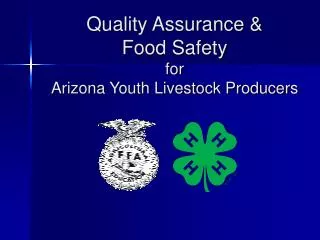
Quality Assurance & Food Safety for Arizona Youth Livestock Producers
Quality Assurance & Food Safety for Arizona Youth Livestock Producers. What is Quality Assurance?. Quality Are the products good to eat? Are they safe and healthy? Do they taste good? Are they tender?. What is Quality Assurance?. Assurance: A pledge or a promise Quality Assurance
601 views • 38 slides
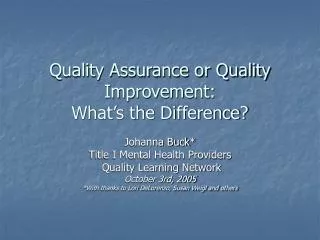
Quality Assurance or Quality Improvement: What’s the Difference?
Quality Assurance or Quality Improvement: What’s the Difference?. Johanna Buck* Title I Mental Health Providers Quality Learning Network October 3rd, 2005 *With thanks to Lori DeLorenzo, Susan Weigl and others. Quality Alphabet Soup. Quality Assurance.
423 views • 13 slides
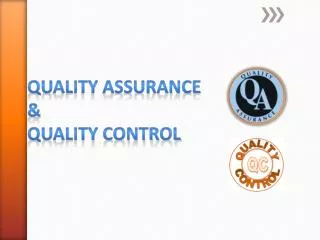
Quality Assurance & Quality Control
Quality Assurance & Quality Control. Quality Assurance. A planned set of activities necessary to provide adequate confidence that requirements are properly established and products or service conform to specified requirements. Sets up measurement programs to evaluate processes.
849 views • 27 slides
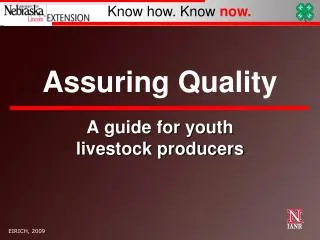
Assuring Quality
Assuring Quality. A guide for youth livestock producers. EIRICH, 2009. What is Quality Assurance?. Quality: Are the products that come from animals: Safe and Healthy? Good Consumer Experiences? Assurance: A pledge or a promise To consumers. Quality Assurance Promise.
642 views • 45 slides

QUALITY ASSURANCE
QUALITY ASSURANCE. Air Cdre (R) Muhammad Ismail Director Quality Assurance (NUST) 07 March, 2008. PRESENTATION PLAN. Introduction Quality Assurance: Definition, Need & Improvement QEC Functions and Organization Self-Assessment
1.34k views • 87 slides
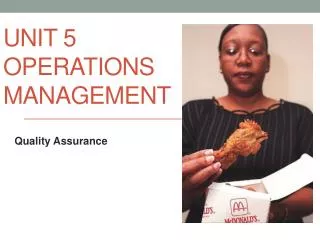
Unit 5 Operations Management
Unit 5 Operations Management. Quality Assurance. Learning Objectives. To be able to explain the concept of quality To understand the difference between quality control and quality assurance – total quality management
405 views • 22 slides
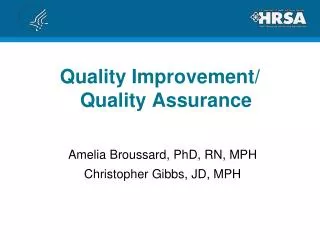
Quality Improvement/ Quality Assurance
Quality Improvement/ Quality Assurance. Amelia Broussard, PhD, RN, MPH Christopher Gibbs, JD, MPH. Understanding Quality Improvement and Quality Assurance. Quality Assurance and Quality Improvement are often confused as the same process Terms used interchangeably but not the same
1.15k views • 24 slides
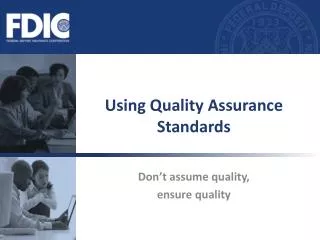
Using Quality Assurance Standards
Using Quality Assurance Standards. Don’t assume quality, ensure quality. Learning Objectives. At the end of this module, you will be able to: Identify the difference between Quality Assurance (QA) and Quality Control (QC). Identify ISO 9000 and Six Sigma programs.
333 views • 21 slides

Quality Assurance or Quality Improvement: What’s the Difference?
Quality Assurance or Quality Improvement: What’s the Difference?. Johanna Buck* Title I Mental Health Providers Quality Learning Network October 3rd, 2005 *With thanks to Lori DeLorenzo, Susan Weigl and others. Quality Alphabet Soup. Quality Assurance.
687 views • 13 slides

QUALITY ASSURANCE PROGRAM
QUALITY ASSURANCE PROGRAM. STATE the duties, responsibilities, and qualification requirements of the following personnel in relation to Quality Assurance: CO XO DHs Division Officer Work Center Supervisor Craftsman Quality Assurance Officer Quality Assurance Inspector NTD Examiner
1.63k views • 51 slides
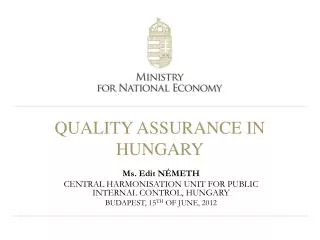
QUALITY ASSURANCE IN HUNGARY
QUALITY ASSURANCE IN HUNGARY. Ms. Edit NÉMETH CENTRAL HARMONISATION UNIT FOR PUBLIC INTERNAL CONTROL, HUNGARY BUDAPEST, 15 TH OF JUNE, 2012. CONTENT. TWO TYPES OF QUALITY ASSURANCE QA in internal audit activity QA performed by Central Harmonisation Unit. QA IN INTERNAL AUDIT ACTIVITY.
346 views • 14 slides
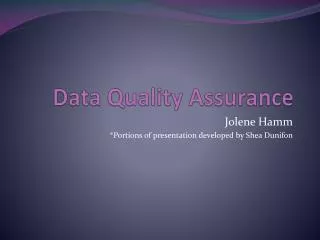
Data Quality Assurance
Data Quality Assurance. Jolene Hamm *Portions of presentation developed by Shea Dunifon. Quality Assurance Processes. Data Quality Assurance at FAEIS. Annual system check by institution Program Manager runs reports by area Quality Assurance Review
610 views • 27 slides
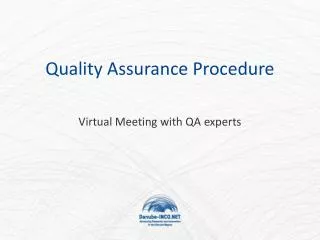
Quality Assurance Procedure
Quality Assurance Procedure. Virtual Meeting with QA experts. T1.4 Quality assurance task. Main goal : assure the high quality level of deliverables and key project events Internal QA is performed by Slovenian Ministry of Education , Science and Sport (MIZS)
329 views • 9 slides
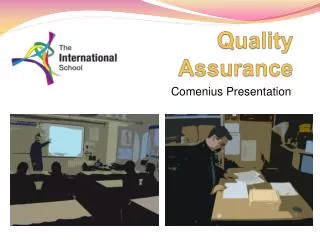
Quality Assurance
Quality Assurance. Comenius Presentation. Our school (The International School). Since September 2010, our school has been refurbished and opens in February 2011. The new school has quality assurance as its core. External Quality Assurance.
377 views • 13 slides
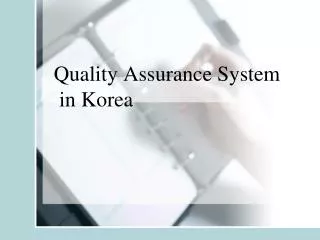
Quality Assurance System in Korea
Quality Assurance System in Korea. 1-1. Quality Assurance in Korea. Accreditation Institution: Korean Council for University Education(KCUE) A primary function of KCUE is quality assurance in its member universities. Establishment: 1982 Role: institutional and programmatic accreditor.
279 views • 12 slides
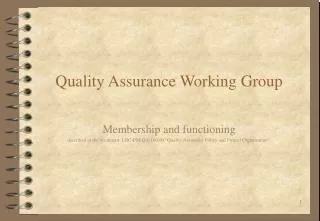
Quality Assurance Working Group
Quality Assurance Working Group. Membership and functioning described in the document LHC-PM-QA-100.00 "Quality Assurance Policy and Project Organization”. Quality Assurance: WHY.
445 views • 9 slides

Software Quality Assurance
Software Quality Assurance. 國立中興大學 資訊管理系 沈肇基. 1. 主 要 大 綱. 什麼是 S/W Quality - Quality Factors SQA Judgement - 完成度分析 S/W Quality Assurance (SQA) S/W Quality Control (SQC) - Maintainability -Reusability -Reliability S/W Metrics
472 views • 9 slides

Accreditation as Quality Assurance Measure at SQU
By: Prof. Adel Gastli Director, Quality Assurance Office. Sultan Qaboos University Quality Assurance Office. Accreditation as Quality Assurance Measure at SQU. QUALITY. Content. Accreditation and its Consequences Accreditation at SQU Quality Assurance at SQU.
495 views • 26 slides

Ongoing Quality Assurance for NOx and SO 2 CEMS
Ongoing Quality Assurance for NOx and SO 2 CEMS. Louis Nichols US EPA, Clean Air Markets Division (CAMD) June 2007. Focus. Quality Assurance tests Ongoing quality assurance (QA) requirements Recertification Events. Post Certification (Ongoing) Quality Assurance.
582 views • 35 slides

Quality Assurance Software Quality Assurance Implementation Plans
Quality Assurance Software Quality Assurance Implementation Plans. October 16, 2003 Defense Nuclear Facilities Safety Board. Beverly Cook Assistant Secretary Office of Environment, Safety and Health. Accomplishments. Quality Assurance Improvement Plan EM: 14 of 16 commitments completed
321 views • 10 slides

Quality Assurance
Quality Assurance. José Viegas Ribeiro IGF, Portugal SIGMA PEM PAL workshop Lviv , 11/12 October 2012. Quality Assurance. An IA quality program should consist of: Continuous/ ongoing monitoring Internal quality assessments; External quality assessment. Elements of Quality Review.
443 views • 18 slides

QUALITY ASSURANCE TRAINING DOE O 414.1C AND 10 CFR 830, SUBPART A
QUALITY ASSURANCE TRAINING DOE O 414.1C AND 10 CFR 830, SUBPART A. Instructor:. LEARNING OBJECTIVES. Articulate the Underlying Principles of Quality Assurance Discuss the interrelationships between Quality Assurance, Integrated Safety Management, and the Price-Anderson Amendments Act
788 views • 51 slides
























